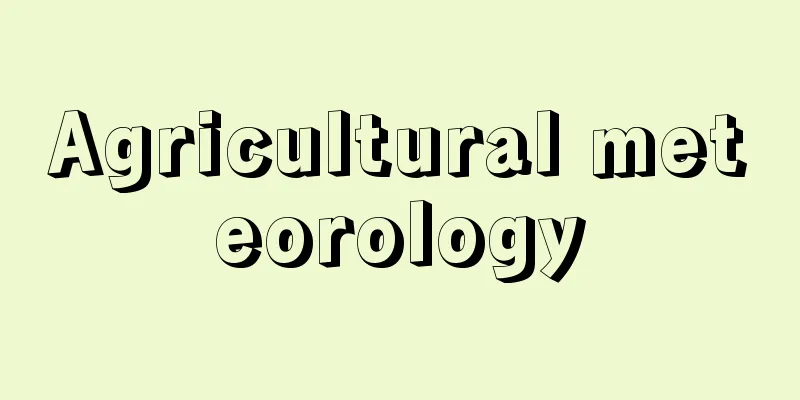Village community - village community English

|
Generally, it refers to the rural social form that formed the basis of feudal society, but also refers more broadly to various forms of rural communities, and can also be used to refer to the ownership forms characteristic of pre-modern societies and the social forms based on them. [Hasumi Otohiko] Three types of rural communitiesIn the primitive community, the first social form of mankind, joint production activities were carried out on a tribal basis, and independent economic activities and private property did not arise for individual families. In contrast to the primitive community as a tribal group that preceded the establishment of private property, the agricultural community is a community that exists after the stage at which productive forces have developed and part of the land has been transferred to private ownership. Rural communities are generally distinguished into three forms based on Marx's theory. The first form is the Asiatic community, where private ownership is still in its embryonic stage, with only houses and a small amount of gardens and farmland being privately owned, and all cultivated land still owned by the community. In the second form, the classical ancient community, the majority of production is carried out on cultivated land that is held in common, but at the same time, private ownership of cultivated land and other areas is recognized. In the third form, the Germanic community, in addition to houses and gardens and farmland, the majority of the cultivated land is also privately owned, but pastures and forests are still held in common, and production is not possible without these complements. In accordance with the form of land ownership, which indicates the degree of independence of these rural communities and therefore of private management, class relations in each society developed. In Asiatic communities, the use of irrigation water led to the development of total slavery under absolute monarchs, while in classical ancient communities the basis of aristocratic societies with slaves was established as seen in city-states. And in Germanic communities, medieval serfdom was linked. In this way, the community was the basic social form that constituted pre-modern societies, but in the process of primitive accumulation that led to the formation of capitalism, various forms of land enclosure progressed based on the rapid development of agricultural productivity, and complete private ownership of land was established. At the same time, the self-employed peasants broke up and the rural community was disintegrated. [Hasumi Otohiko] Closedness and equalityIn premodern societies, with low productivity and a self-sufficient economy, community members formed localized microcosms and cooperated closely with each other, enabling the reproduction of their members. Within communities, closedness was emphasized from the outside world, while equality was emphasized internally. While members were bound together with a family-like closeness, they adopted an almost hostile and exclusive attitude toward those outside the group. Furthermore, within communities, the private activities of individual business entities based on privately owned land, etc., were permitted only to the extent that they did not conflict with the joint activities aimed at the reproduction of the whole. As private business developed, there were increasing cases of conflict with the community, but the free subjectivity of individuals had to be restrained through community regulations. [Hasumi Otohiko] Characteristics of Japanese VillagesAlthough the term "village community" generally refers to various forms of agricultural communities, particularly the Germanic community that formed the basis of medieval feudal society, it is sometimes used to refer to agricultural communities in general. This is due in part to the fact that in Asian societies, including Japan, there are differences from Western Europe in the development of communities and the nature of communities in feudal societies. Early modern Japanese villages, centered around farmers, can be seen as village communities in the sense that they had private ownership of cultivated land and common land such as forests and wilderness that was owned by the community, but on the other hand, the cultivated land was also under the control of the community through irrigation water. At the same time, an important factor that determined the characteristics of Japanese villages was that they were used as a mechanism for governing peasants in early modern feudal society, and they were positioned as feudal villages because they were required to take collective responsibility for village matters, including the payment of annual taxes. Furthermore, in the case of Japan, during the formation of modern capitalism after the Meiji period, unlike Europe, there was no significant agricultural revolution, and no progress in the disintegration of the peasant class through enclosure. Therefore, village communities did not show clear signs of disintegration, but were instead reorganized as wards and villages at the end of administrative villages under the state system after the Meiji period. Moreover, with the development of the landlord system, villages also functioned as an institution for landlords to control the peasants. As a result, even after the Meiji period, social forms indistinguishable from village communities were found in rural areas. The landlord system was dismantled by the land reform after the Second World War, and villages lost their role as an institution for controlling the peasants. It is believed that the village community-like characteristics of Japanese villages finally disappeared as a result of the rapid changes in rural society during the subsequent high economic growth. [Hasumi Otohiko] "Forms Antecedent to Capitalist Production" by K. Marx, translated by Masaki Teshima (Otsuki Shoten, Kokumin Bunko)" ▽ "The Social Structure of the Japanese Village" by Nao Fukutake (1959, University of Tokyo Press) ▽ "The Basic Theory of Community" by Hisao Otsuka (1955, Iwanami Shoten) ▽ "The Japanese Village Community" by Yoshiharu Nakamura (1957, Nippon Hyoron Shinsha)" [References] | | | | |Source: Shogakukan Encyclopedia Nipponica About Encyclopedia Nipponica Information | Legend |
|
一般には封建社会の基底をなした農村の社会形態を意味する。それ以外に、より広く農村共同体のさまざまな形態を意味し、前近代社会に特徴的な所有形態とそれを基礎とする社会形態をさして使われる場合もある。 [蓮見音彦] 農村共同体の三形態人類の最初の社会形態である原始共同体では、種族団体を単位に共同の生産活動が行われ、個々の家族の独立した経済活動、私有財産は生じていなかったが、この私有財産の成立に先だつ種族団体としての原始共同体に対して、生産力が発展して土地の一部が私的所有に移行した段階以降の共同体が農村共同体である。農村共同体は、一般にマルクスの学説に基づいて、三つの形態に区別される。第一の形態はアジア的共同体であり、そこでは私有はなお萌芽(ほうが)的部分にとどまり、家屋とわずかの庭畑地のみが私有され、耕地はまだすべて共同体の所有とされている。第二の古典古代的共同体では、生産の主要な部分は、共有の下にある耕地で行われているが、それとともに開墾地などの私有が認められるようになっている。さらに第三のゲルマン的共同体では、家屋・庭畑地以外に主要な耕地までも私有されているが、牧草地・森林などはまだ共有とされ、これらの補完なしには生産が成り立たない状態にある。こうした農村共同体の、したがってまた私的経営の自立の程度を示す土地所有の形態に対応して、それぞれの社会の階級関係が展開する。すなわち、アジア的共同体では灌漑(かんがい)用水を契機に専制君主の下での総体的奴隷制が発展し、古典古代的共同体は、都市国家にみられるように奴隷を伴った貴族社会の基盤となる。そしてゲルマン的共同体は中世農奴制と結び付いたのであった。 このようにして共同体は前近代社会を構成する基底的な社会形態であるが、資本主義の形成を導く本源的蓄積の過程で、農業生産力の飛躍的な発展に基づいてさまざまな形での土地の囲い込みが進み、土地の全面的な私有が確立する。それと同時に自営小農民の分解が進み、農村共同体は解体を遂げることになる。 [蓮見音彦] 封鎖性と平等性前近代社会では、低い生産力と自給経済の下で、共同体の成員が局地的小宇宙を形成して相互に緊密に協力しあい、その構成員の再生産を可能にしてきた。共同体においては対外的には封鎖性、対内的には平等性が強調され、仲間の間では一家族のような親しさをもって結び付きながら、集団外に対しては敵対的なまでの排他的態度がとられた。また、共同体においては、私有の土地などに基礎を置く個々の経営体の私的活動は、全体の再生産を目的とした共同の活動と矛盾しない範囲内でしか許されない。私的経営の発展に伴って、共同体との間に矛盾を生じる場合が増大するが、個々人の自由な主体性は、共同体的規制を通じて抑制されなければならなかった。 [蓮見音彦] 日本の村落の特質村落共同体ということばが、一般的には、農村共同体の諸形態のうち、ことに中世封建社会の基底をなしたゲルマン的共同体を意味するにもかかわらず、包括的に農村共同体を意味することもあるのは、一つには、日本を含めたアジア社会などの場合には、共同体の展開や封建社会の共同体のあり方などに、西欧の場合と異なる点があることに基づくものである。日本の近世の本百姓を中心とする村は、耕地の私有と山林原野などの共同体による所有としての入会(いりあい)地をもつという点で村落共同体とみることのできるものであるが、一面では灌漑用水を介して耕地も共同体の統制の下に置かれていた。それと同時に、日本の村落の特質を規定した要因としては、村が近世封建社会の農民統治の機構とされ、年貢の納入をはじめとして、村の連帯責任が求められて藩政村として位置づけられたことが重要である。 さらに、日本の場合には、明治以降の近代資本主義の形成過程において、ヨーロッパの場合のように顕著な農業革命がみられず、囲い込みを通じての農民層分解の進行がみられなかったことから、村落共同体が明確な形での解体を示さず、むしろ明治以降の国家体制の下で、行政村の末端としての区や村落として再編成された。しかも、地主制の発展に伴い、村は地主の農民支配の機構としても機能した。その結果、明治以降も農村には村落共同体と区別しがたい社会形態がみいだされた。第二次世界大戦後の農地改革によって地主制が解体され、村から農民支配の機構としての役割が失われ、その後の高度経済成長の過程での農村社会の激しい変動に揺るがされることによって、日本の村の村落共同体的な特質はようやく解消してゆくことになったものとみられている。 [蓮見音彦] 『K・マルクス著、手島正毅訳『資本主義的生産に先行する諸形態』(大月書店・国民文庫)』▽『福武直著『日本村落の社会構造』(1959・東京大学出版会)』▽『大塚久雄著『共同体の基礎理論』(1955・岩波書店)』▽『中村吉治著『日本の村落共同体』(1957・日本評論新社)』 [参照項目] | | | | |出典 小学館 日本大百科全書(ニッポニカ)日本大百科全書(ニッポニカ)について 情報 | 凡例 |
Recommend
Fortified foods - fortified foods
Foods that have been fortified with vitamins, min...
papilla mammal
…the swelling that covers the mammary glands of m...
Rock tunnel method - Ganbankoudouhoshiki
…When the coal seam is reached through a vertical...
Parnasse contemporary (English)
…This is a translation of the term l'école pa...
Smithson, P. (English spelling) SmithsonP
… While the mainstream of British architecture in...
Deviant Phenomenon
...However, tests of blood glucose regulation are...
Comb
〘noun〙 The ridge of a roof. Source: The Selected E...
Fisheries Mutual Aid - Gyokaku Kyosai
…After six years of testing conducted by the gove...
Special local consumption tax - tokubetsuchihoshohizei
Its predecessor was called the entertainment and ...
Giuseppe Arcimboldo
Italian painter. Born in Milan, where he died. He...
The Three Graces - Sanbishin
Original title: De drie gratiën (Dutch) A painting...
Epithelium - Wow
〘 noun 〙① Something that covers the surface of som...
David
A Flemish painter. After Memling's death in 14...
Tayassu pecari (English spelling)
...A boar-like even-toed ungulate found in North ...
Asuko-kenda - Asuko-kenda
... Ascocentrum was once classified as part of th...









